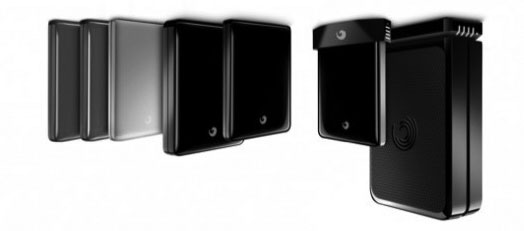
John gave us a quick look at Seagate’s attempt at reinventing the external hard drive yesterday. His hands-on video is here, but the concept is simple enough. It’s an external hard drive with a native SATA port on the rear side where different proprietary cables convert the interface into USB 2.0, USB 3.0, eSATA, and Firewire. The thought is that this system not only future-proofs the hard drive, but also allows it to be used on nearly any computer system.
I lost sleep over this system last night. There is nothing I hate more than proprietary cabling systems. I would rather go on a cross-country motorcycle trip with my mother-in-law than own a system such as this. In fact I hope the GoFlex system dies a quick death before other storage companies replicated the idea and out their own versions. If that happens, it will be the end of the world as we know it. Seriously.
The core idea is innocent enough. Seagate wants users to be able to use their hard drives on any computer. That’s great and a noble cause. But the GoFlex system relies on a system of proprietary cables. Without these cables, the system will only work on SATA — not eSATA mind you.
You know what this means, right? You’re SOL if you lose one of these cables. Or if the clunky interface connector breaks. Or bring the wrong cable to your buddies house because it’s not like he’s going to have one in his cable bin.
You’re also relying on Seagate supporting the system for years to come. It’s not like Monoprice is going to sell these cables. If the system flops, Best Buy and Radio Shack aren’t going to stock the cables and so you’re going to have to order them directly from Seagate, which could be bad news bears if you need to use the drive immediately.
I’m sure I wouldn’t have a big problem with the GoFlex system if it was solving a common problem. But when was the last time you couldn’t connect an external hard drive to a computer? I mean, every single computer on this planet has a USB 2.0 port and most systems 2 years old even have eSATA, which as I found is actually faster than USB 3.0. Sure, you might not be taking full advantage of the drive with the fastest speeds available, but currently USB 2.0 is compatible with nearly every system. Simply adding an eSATA port to most external drives will give users a faster option if it’s available. Plus it any generic cable will work fine.
All I’m saying is that there simply isn’t a need for such a system. Seagate has had some major hits over the last few months and I love their products. But trading universal compatibility for a proprietary cabling system is like selling your soul to the devil. Only, in this case, the devil is a cable. And it’s not your soul.